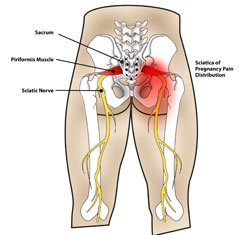What is Piriformis Syndrome?
Piriformis syndrome is a muscle disorder that occurs when the sciatic nerve is compressed or otherwise irritated by the piriformis muscle causing pain, tingling and numbness in the buttocks and along the path of the sciatic nerve descending the lower thigh and into the leg. The most important criterion is the exclusion of sciatica resulting from compression/irritation of spinal nerve roots, as by a herniated disc. Many pregnant patients get misdiagnosed with sciatica when in reality they have piriformis syndrome commonly know as pseudo-sciatica.
For more information on Pregnancy Chiropractic Care
The syndrome may be due to anatomical variations in the hip misalignment, muscle-nerve relationship, or from overuse or strain. Uncontrolled studies have suggested theories about the disorder, however a large scale formal prospective outcome trial found that the weight of the evidence-based medicine is that piriformis syndrome should be considered as a possible diagnosis when sciatica occurs without a clear spinal cause.
In addition to causing pain that may radiate down your buttocks and leg, the Piriformis Syndrome may present with pain that is relieved by walking with the foot on the involved side pointing (toe-out) outward. This position externally rotates the hip, lessening the stretch on the piriformis and relieving the pain slightly. Piriformis syndrome is also known as “wallet sciatica” or “fat wallet syndrome,” as the condition can be caused or aggravated by sitting with a large wallet in the affected side’s rear pocket.
addition to causing pain that may radiate down your buttocks and leg, the Piriformis Syndrome may present with pain that is relieved by walking with the foot on the involved side pointing (toe-out) outward. This position externally rotates the hip, lessening the stretch on the piriformis and relieving the pain slightly. Piriformis syndrome is also known as “wallet sciatica” or “fat wallet syndrome,” as the condition can be caused or aggravated by sitting with a large wallet in the affected side’s rear pocket.
Conservative treatment usually begins with stretching exercises, myofascial release, massage, and avoidance of contributory activities, such as running, bicycling, rowing, etc. Some chiropractic treatment is also recommended, including soft tissue mobilization, hip joint mobilization, teaching stretching techniques, and strengthening of the gluteus maximus, gluteus medius, and biceps femoris to reduce strain on the piriformis.
Dr. Bagnell has had great success in treating patients with Piriformis Syndrome over the years. Contact our office today and make an appointment (215)504-2711.
